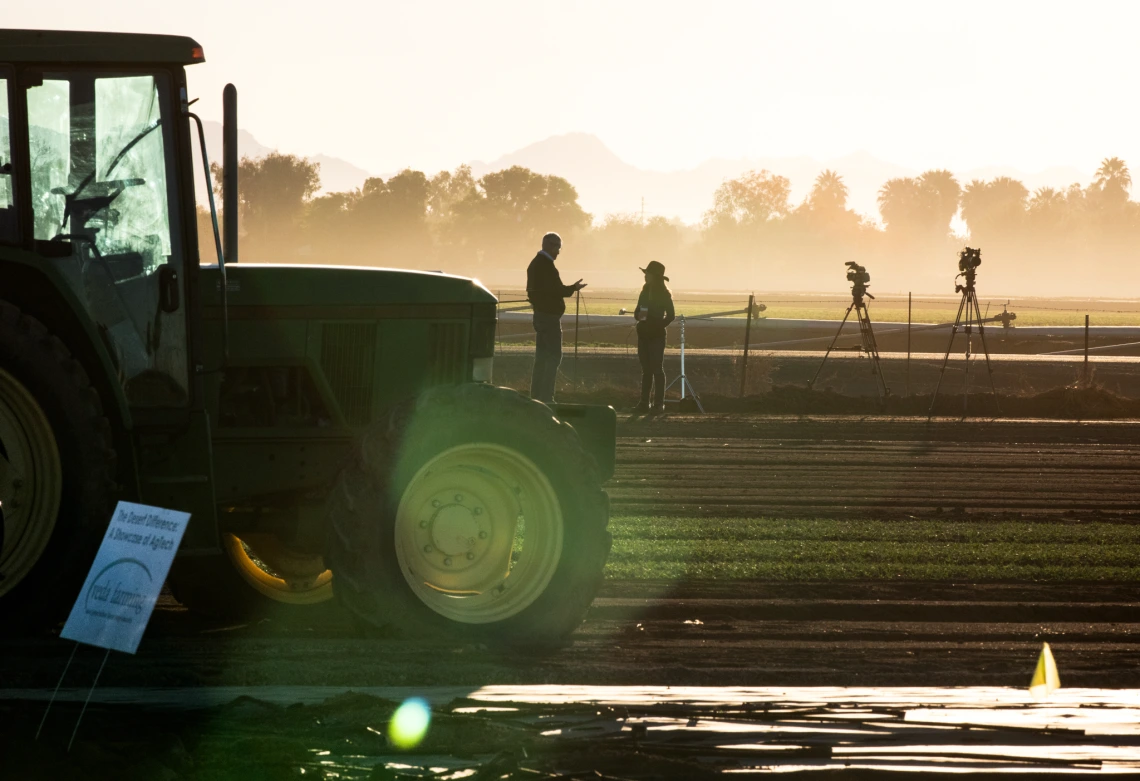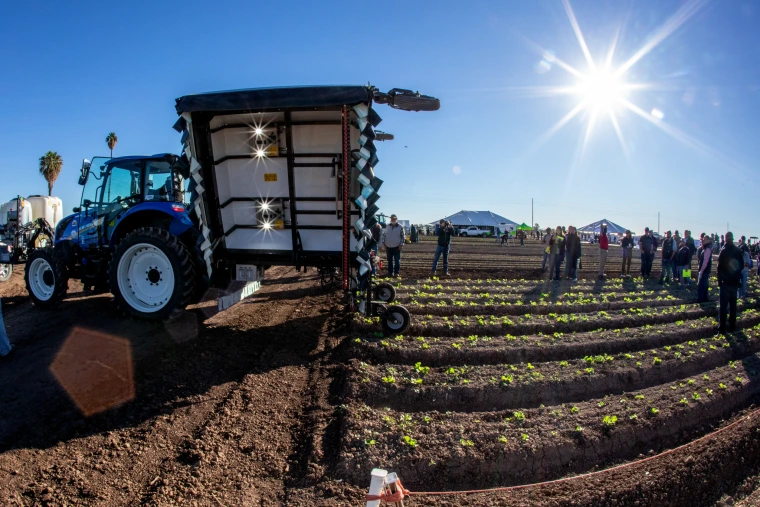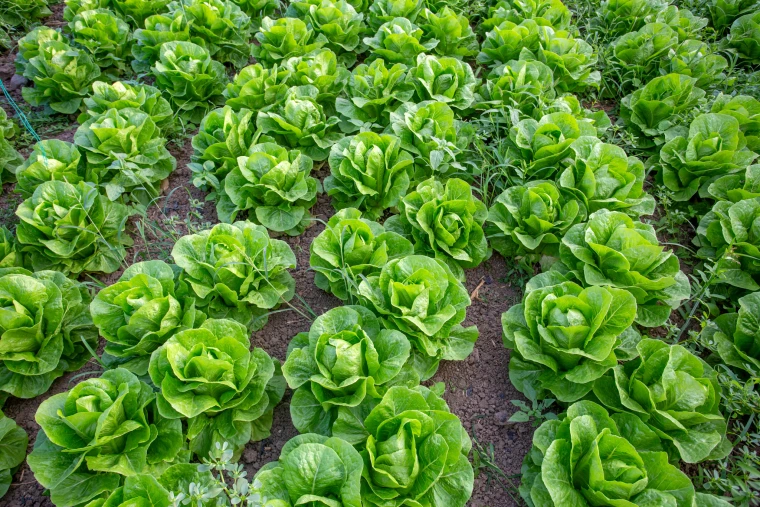Keeping Yuma Connected
How innovations in infrastructure are helping Yuma face the future.

Leslie Hawthorne Klingler photos
Yuma’s agriculture is a powerhouse, feeding the nation and fueling the economy.
Known as the Winter Salad Bowl, it supplies 90% of the country’s leafy greens from November to March and ranks first in Arizona for vegetable production. A new economic impact study shows Yuma’s agriculture and agribusiness contributed $4.4 billion to Arizona’s economy in 2022, with $3.9 billion staying in Yuma County.
The University of Arizona supports the industry through research and education at its Yuma-based facilities and six agriculture-related degree programs.
“Yuma is a dynamic place with sophisticated agricultural operations that play a key role in winter vegetable supply chains at the national level,” says Dari Duval, an economic impact analyst with the U of A Cooperative Extension and Department of Agricultural & Resource Economics in the U of A College of Agriculture, Life and Environmental Sciences. “Agribusiness in Yuma goes far beyond on-farm production to include operations providing inputs, specialized services and carefully coordinated post-harvest activities.”

Leslie Hawthorne Klingler photos
Driving this success is innovation. U of A research is advancing the use of technology in farming and agribusiness, helping farmers improve yields and adapt to changing environmental conditions. By collecting and monitoring field data, producers can better plan and assess crop growth, ensuring Yuma remains a leader in agricultural production.
Internet-connected devices have revolutionized agriculture by enabling real-time monitoring and precision management of crops, livestock and equipment. From soil moisture sensors for irrigation to drones that monitor crop health from above to laser weeders that use artificial intelligence, these connected devices provide farmers with valuable data to improve efficiency.
Combined with Yuma’s innovative arid-land crop production practices, such devices can be crucial for sustainability research. However, until recently — despite the area’s global importance and economic potential — the region faced challenges with connectivity and internet access, which is crucial for education, economic development and agriculture.
Now, thanks to a subaward from the National Science Foundation’s Campus Cyberinfrastructure program, Yuma growers have access to 10G fiber broadband. The project helped position Yuma as a key center for precision agriculture and arid-environment sustainability.
“Yuma is the agriculture powerhouse for leafy greens for the nation, but we were not able to convince these big internet service providers to come out, so we were hampered by the limitations of the network that we had,” says Matt Rahr, director of the Cyber Experiment Station. “Enter the Sun Corridor Network, which looked at this from a research and education angle, and here we are bringing true fiber technology to the farm.”
The Campus Cyberinfrastructure program invests in projects that help overcome disparities in connectivity associated with geographical location. Partnered with the Sun Corridor Network, the initiative helped deliver high-speed external connectivity, wireless networks and Internet of Things systems to the Yuma Agricultural Center within the Arizona Experiment Station, the University of Arizona Yuma, Arizona Western College and the Yuma Union High School District.
Recognizing the need for internet infrastructure, the team set out to bridge the connectivity gap in Yuma. They implemented a three-tier service system including Wi-Fi, a wireless broadband service for cellular data and a low-power, wide-area networking service that allows battery- and solar-operated devices to connect to the internet. This all-encompassing approach ensures that Yuma now receives high-speed internet.
“Now there is a location to come and test, train for and showcase agricultural technology, so when the technology is ready to go to the farmer it is ready to be implemented,” says Tanya Hodges, executive director of the Yuma Center of Excellence for Desert Agriculture. “The big goal is for all of Yuma to integrate smart-farm capabilities, and this is one piece of that puzzle.”
The goal is for improved connectivity to extend beyond research farming to everyday agricultural operations. As high-speed internet becomes more widespread, the use of internet-connected technologies in farming practices can grow, enabling more precise, tech-driven agricultural methods.

Leslie Hawthorne Klingler photos
Driving Innovation
The Desert Difference AgTech Conference in Yuma this past November brought together a diverse audience to shape the future of agriculture in arid regions. Growers, researchers, industry leaders and government and nonprofit representatives gathered to explore innovations transforming desert farming.
The conference showcased cutting-edge advancements in precision planting, irrigation, crop thinning and automation for harvesting and weed management. Field demonstrations at the U of A’s Agricultural Research Center highlighted how data-driven decision-making is transforming agriculture while also revealing challenges such as high costs and adaptation hurdles. Experts emphasized the economic impact of agricultural technology, particularly for rural communities.
“The integration of AgTech into Arizona’s farming systems is not just about innovation; it’s about creating lasting economic growth, particularly for rural communities,” said Jamie Kerr, vice president of rural economic development at the Arizona Commerce Authority.
Panel discussions explored the future of smart farming, addressing issues like water scarcity, labor shortages and rural broadband limitations. Speakers examined how regulations in Arizona and California shape the adoption of agricultural technology and the need for policies that balance innovation with sustainability.
Speakers also reinforced the importance of international collaboration in tackling agricultural challenges. The conference concluded with a focus on smart farm integration, emphasizing the need for partnerships, adaptability and a commitment to equity in advancing agricultural technology.
“Transformative solutions in agriculture don’t happen in isolation or just with fancy technologies,” says Hodges. “They require everyone involved to come together and solve truly complex challenges.”

Leslie Hawthorne Klingler photos
Yuma Economic Impact Study
Researchers have found that produce grown in Yuma generates a whopping $3.2 billion in retail value, ranking the county third nationwide in sales of vegetables and melons.
The economic impact report also found that for every $1,000 of vegetables sold, less than one acre-foot of water — enough to cover one acre of land to a depth of one foot — was used.
“There’s this concern about how much water is being used and if it’s being used efficiently,” says George Frisvold, who led the study and is a professor in the Department of Agricultural & Resource Economics in CALES. “In Yuma, they use 0.63 acre-feet to produce $1,000 worth of crops — compared to the rest of the Colorado Basin, where the average amount used is 1.44 acre-feet to produce a similar value.”
The report places Yuma among the nation’s major agricultural producers, with vegetable farmers being 58 times more concentrated in the county than the national average. That density surpasses many specialized hubs, including Detroit’s vehicle manufacturing sector.
“The study findings provide a very important resource for planning and decision-making,” says José Quintero, an agricultural enterprise analyst in the Department of Agricultural & Resource Economics in CALES.
By the numbers
To provide a comprehensive analysis of the county’s agricultural impact, researchers used a multiregional input-output model to quantify the direct and indirect contributions of farming, agribusiness and related industries.
“The results were obtained using the most current and accurate data available, primarily from the latest USDA Census of Agriculture in 2022,” says Claudia V. Montanía, an economic impact analyst in the Department of Agricultural & Resource Economics in CALES. “This allows the estimated numbers to reflect the agricultural production structure of Yuma County.”
Researchers found that of the $3.9 billion dollars in economic activity created in Yuma County, agricultural operations directly contributed $2.8 billion — including $1.3 billion from crop industries, $167 million from livestock industries, $1.3 billion from agricultural support services and suppliers, and $4 million from university-related agricultural research and Cooperative Extension activities.


